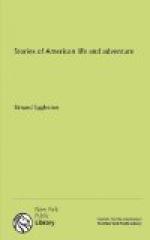Blackbeard, thinking that most of Maynard’s men had been killed, jumped on board the sloop with fourteen men. Maynard now called his men from below, and there was a desperate fight. Blackbeard was shot five times, and was wounded with swords; but the old monster fought until he fell down dead while cocking his pistol. The rest of the pirates on the deck of Maynard’s ship were taken prisoners.
Maynard’s other sloop was fighting with the men left on board Blackbeard’s vessels. These surrendered, but they had trouble to keep the big negro from setting fire to the gunpowder and blowing them all up.
Maynard took away from the Governor of North Carolina many hogsheads of sugar that Blackbeard had stolen. Then he hung the great ugly head of the pirate at the bow of his ship, and sailed back to Virginia in triumph.
AN OLD PHILADELPHIA SCHOOL.
There was a schoolmaster in Philadelphia before the Revolution who did not like to beat his pupils as other masters of that time did. When a boy behaved badly, he would take his switch and stick it into the back of the boy’s coat collar so that the switch should rise above his head in the air. He would then stand the boy up on a bench in sight of the school, in order to punish him by making him ashamed.
This schoolmaster’s name was Dove. If any boy was not at school in time, the master would send a committee of five or six of the scholars to fetch him. One of this committee carried a lighted lantern, while another had a bell in his hand. The tardy scholar had to march down the street in broad daylight with a lantern to show him the way, and a boy ringing the school bell to let him know that it was time for him to be there.
[Illustration: The Tardy Schoolmaster.]
One morning Mr. Dove slept too late, or forgot himself. The boys made up a committee to bring the teacher to school. They took the lantern and the bell with them. Mr. Dove said they were quite right. He took his place in the procession, and the people saw Schoolmaster Dove taken to school late with a lantern and a bell.
The larger schoolboys of that time were very fond of foot races. They would take off their coats and tie handkerchiefs about their heads before starting. The short breeches they wore were fastened at the knee by bands. When they were going to run a race, they would loosen these bands, and pull off their shoes and stockings. Some of the boys ran barefoot in this way, but others wore Indian moccasins. The race course was round a block; that is, about three quarters of a mile. Crowds would gather to see the boys run, and the people rushed from one side of the block to the other to see which was leading in the race.
A DUTCH FAMILY IN THE REVOLUTION.
What is now the State of New York was first settled by people from Holland who spoke the Dutch language. New York afterward became an English colony, but the Dutch settlers and their descendants still spoke the language of Holland, at the time of the American Revolution.




